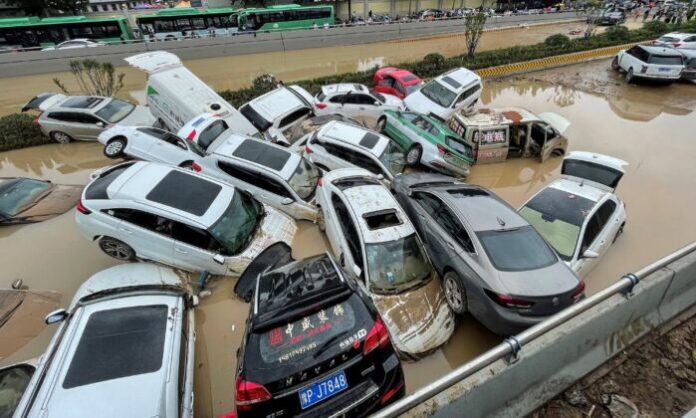From Germany to Canada to China, flooding and wildfires have heralded a new age of climate disaster
Hong Liuxing, chinaworker.info
In Zhengzhou, the capital of Henan province, where at least 302 people have been killed since 20 July, China’s dictatorship, the CCP, has called it a “once in a millennium” flood. But the truth is stark and clear: the climate crisis is here to stay.
As temperatures and sea levels rise, China’s densely populated eastern seaboard is under serious threat of ending up underwater. An estimated 43 million people in China live on land that could be submerged if global average temperatures rise by 2C degrees. Worse, massive infrastructure projects like the Three Gorges Dam could be threatened by increased rainfall and melting permafrost.
Coal power spree
China is the biggest greenhouse gas emitter, accounting for 27 percent of the world’s total. Xi Jinping has touted China’s plan to become carbon neutral by 2060. State media has continuously highlighted that China is the world’s largest producer of renewable energies. But none of what the CCP regime has planned is adequate to reach these goals, much less the peak in carbon emissions required by 2025 to avoid major “climate tipping points” that could leave accelerated and irreversible impacts for human life on earth. In fact, a 2020 study coordinated by the Energy Foundation of China and the University of Maryland concluded China must reach carbon neutrality by 2050.
For all their loudly stated climate goals, the CCP’s 14th Five Year Plan makes no reference to specific renewable energy targets and has no plan to cap carbon emissions. In 2020, China built more than three times as much coal power capacity as the rest of the world combined. Hundreds of new coal plants are to be “greenlit” by the National Energy Administration. More than 66% of China’s electricity comes from coal. In part, this is because the for-profit State Grid and China Electricity Council have successfully lobbied for the building of hundreds of new coal power plants in the 14th Five Year Plan by deploying the myth of “clean and efficient” coal.
This reveals directly the capitalist “chamber of commerce” style governance structure of the CCP, where powerful for-profit state-owned energy corporations use the state to amass billions of dollars of profit. But it also has to do with Xi’s position on the world stage and within the party-state, which has been seriously threatened by the New Cold War and economic stagnation following the pandemic. With his 2022 plan to secure lifetime rule, Xi’s attempts to revive the domestic economy has led him to rely on dirty coal, which employs millions and is in plentiful supply within China, unlike natural gas, oil, or lithium (for renewables) power that has to be imported from elsewhere.
Furthermore, the figures on renewable energy spending are “just not possible,” according to Jonathan Luan Dong, a Beijing-based analyst for BloombergNEF. While the government reports having installed 120 gigawatts of wind and solar power in 2020, there is little evidence for it as no subsequent impact on supply chains can be found. The National Energy Administration has also chosen not to provide figures on wind installation data for 2020. Data fudging to project propaganda power to investors and potential allies in the new imperialist Cold War conflict will cause the mutual destruction of contending capitalist powers when the planet’s ecosystem begins to collapse.
The market is the problem
China’s drive towards renewable energies is largely market driven, with it now having the second largest “green finance” market where the Chinese capitalist class could reap massive profits. However, as renewable energies are scaled up, the price of solar or wind will begin to drop until it is no longer profitable to deploy new renewable power plants. This profit rationale ultimately prevents capitalism from being able to fully transition to a carbon neutral economy and is why a democratically planned economy is the only way to combat climate change.
A second mechanism that the CCP has introduced is a national carbon market, which will become the world’s largest carbon market. A so-called carbon market puts carbon emission caps on factories, requiring them to buy “carbon pollution permits” on the market to emit more pollution. There are serious limitations to this policy, with a current “pollution amnesty” in place for all polluters that essentially make the market entirely speculative. Similar, more restrictive models that already exist elsewhere, like in the EU, have had 15 years of implementation with no lowered emissions to show for this.
The reason why carbon markets inherently don’t work is that they are essentially a diversionary tactic that allows big polluters to profit even more from their customers. It will enable companies like Sinopec (China’s biggest oil and gas company) to justify increased costs on essential commodities, raking in billions more in profits while the fossil fuels continue to be taken out of the ground.
Just this week, Sinopec conducted a bulk buy of 100,000 tons of carbon emission quota while simultaneously announcing to grow natural gas output 60 percent by 2025. While they argue this is a net reduction of emissions from coal and oil, natural gas is often more polluting than other fossil fuels due to leakages in the process of extraction. Even worse, the reason for Sinopec’s increase in natural gas is directly related to huge new gas flows discovered in Xinjiang last year, paving the way for more colonial dispossession and exploitation in the restive western region.
Xi’s dream of carbon capture
So far, no real plan has been announced or put in motion to reach the target of a 2060 carbon neutral China. Energy mix models from Tsinghua University project that even by 2060, the ideal energy mix is to have 16 percent of power consumption still sourced from fossil fuels. Projecting an overall doubling in energy consumption, the CCP is planning to “offset” huge amounts of carbon emissions via carbon capture technology.
Like many of the world’s polluter class, carbon capture has been seen as the “saving grace” of capitalism and the planet’s ecosystem, supposedly allowing for and “offsetting” continued economic growth in the trillion-dollar industries of fossil fuel extraction. However, existing carbon capture systems currently only capture 0.1 percent of global emissions, with scaling up the technology looking to be incredibly difficult. Part of the reason for this minuscule rate of adoption is due to the lack of any market for recaptured carbon, as it has to compete with natural carbon.
Again, ironically capitalism’s logic has resulted in almost all major carbon capture investments to be by massive oil corporations, from Exxon Mobil to China’s own Sinopec, which has just launched a “megaton scale carbon capture project.” This is because 81 percent of carbon capture systems are actually used to refine crude oil, revealing that carbon capture is simply a way for polluters to suck more fossil fuels out of the ground. Whether in a billionaire dictatorship or a capitalist “democracy”, the trillion-dollar interests of fossil fuel companies are intimately tied with their political and economic systems, which prevents the ever-elusive “political will” to fight climate change from appearing.
Even if capitalist governments were to implement mass carbon capture systems, it is estimated this would require a landmass equal to all the world’s current cropland. This would make way for massive land grabs and displacements of poor and indigenous people worldwide, lowering the standard of living for working people while the capitalist class continues with “business as usual.”
Capitalism and environmental damage
The justification so far from the CCP regime for mass environmental damage has been the need for rapid economic growth. While we know that this has produced much weaker real gains for working people, with the majority going to China’s growing number of billionaires (over 1,000 according to the 2021 Hurun List), the introduction of environmental cleanup costs into the equation further dampens that narrative.
According to the CCP’s own Ministry of Environmental Protection in 2015, the cost of air, water, and soil pollution cleanup will cost six trillion yuan (US$960 billion). In a UN report from 2018, China’s GDP per capita growth from 1990 to 2015 was 58.4 percent. If, however, the loss of natural resources and ecosystem destabilization were taken into account, the UN’s “inclusive wealth” index reports Chinese GDP per capita to have only grown by 10.2 percent. The CCP’s state capitalism, while able to mobilize comparatively huge economic resources, still suffers from the blind chase for short-term profits which inflict irrevocable damage on our environment.
The response to a growing climate emergency from the CCP has been a slate of climate austerity measures, including Shanghai’s new waste sorting rules implemented in 2019. While household waste is an issue, it is nothing compared to the unregulated industrial pollution that continues to belch out of factories and power plants under the “pollution amnesty”.
Yet Shanghai’s authorities have decided to force working people to bear the brunt of the climate crisis, instating fines of 200 yuan (or 1.5 hours of work for the average wage in Shanghai) whenever they fail to follow a labyrinthine waste sorting system. Chicken bones are wet waste, but pork bones are dry waste, along with a long list of meaningless bureaucratic rules. The hardest hit is Shanghai’s sanitation workers, who have to work overtime to sort rubbish as the municipal government refuses to collect unsorted waste. Without a profit incentive, the ruling capitalist class in China has no interest in ensuring a livable environment for the masses, only to impose brutal eco-austerity when the costs of waste management become too high.
Climate imperialism
The China-US new Cold War will define the battle lines of world capitalism for decades to come. Here, both sides have become increasingly hypocritical. China has financed more than 300 foreign coal plants from Egypt to the Philippines, while Xi claims the Belt and Road Initiative (BRI) must be “clean and sustainable”. With more than 60 percent of BRI investments towards nonrenewable energies, the Biden administration has accused China of outsourcing pollution. But the United States is no better, continuing to spend billions on overseas fossil fuel subsidies. While Biden has written an executive order to stop subsidizing coal plants, the US continues to fund natural gas plants with a higher carbon emission than coal, conveniently creating a dependence upon a fuel source that the US is now massively exporting.
Competition for resources in renewable energies like lithium and cobalt will also likely ramp up. China has secured mining rights in a major cobalt mine in the Democratic Republic of the Congo, where child and slave labour is prevalent and mining pollutants often permanently damage local communities.
Similarly, China has invested US$4.2 billion in lithium deals in South America over the last two years. This has fueled the class struggle over working conditions and indigenous land rights in the Andes, with huge Chinese state-owned enterprises firmly on the side of the local bourgeoisie. The demand for lithium by both sides, vital for making batteries, was one of the factors that led to the coup against Bolivian President Evo Morales in 2019, with billionaire Elon Musk tweeting, “We will coup whoever we want.” The CCP was largely silent on the ousting of Morales’ government by right-wing forces.
Class struggle to save the planet
The only way out of global climate catastrophe is through the power of the working class. This means to overthrow the CCP’s rotten billionaire dictatorship that puts super-profits and its unquestioned power before people and the planet. Without a democratically planned economy, no transition to an ecological society can be made as capitalism has been built upon and continues to rely on fossil fuels as the core to its growth.
Xi’s regime is increasingly fearful of environmental protests, knowing the explosive potential they can have on working class struggle and consciousness. Past protests against incinerators and polluting chemical plants have turned out tens of thousands of working class residents in angry street protests, with the latest being the 2019 Wuhan incinerator protest.
The internationalisation of mass movements has begun to seep into China as well, with an increasing layer of young people radicalised by the dangers of global warming. Greta Thunberg’s climate strike has inspired an incredibly brave 16-year-old Chinese student Howey Ou to attempt to conduct a similar school strike. Ou represents a growing consciousness among youth towards a working class approach to struggle over the planet, stating, “Most environmental organisations are speaking to a middle class that is educated in the cities. But I want to focus on those that are being immediately affected by climate change and can’t speak out.”
The heel of state repression quickly turned against her, with the CCP arresting, interrogating, and barring her from returning to school. Xi Jinping’s “environmentalism” has been thoroughly exposed as a sham, and the CCP fears the day the massive Chinese working class rises up against their dictatorial plunder of nature. Workers and students in China must organise, build independent trade unions and student organisations, and fight for the democratic mass control of all fossil fuel industries and other dominant economic sectors to transition towards an ecological and genuinely socialist society.




